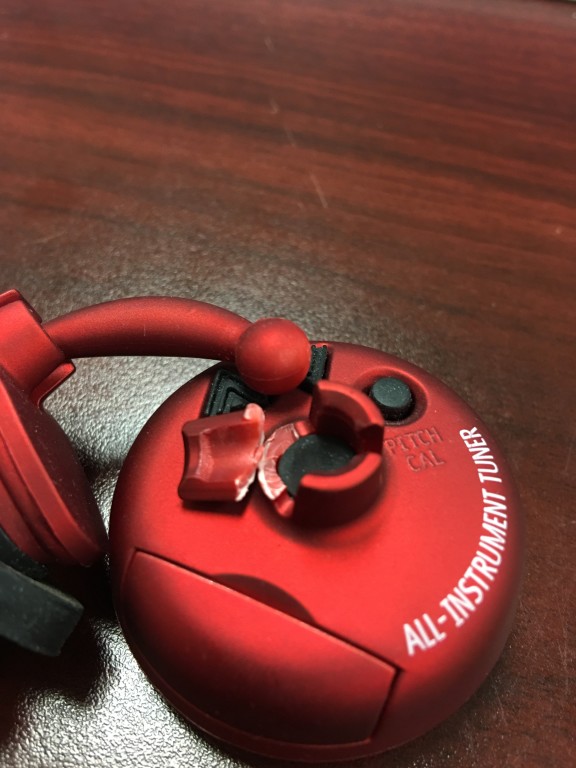When I bought my latest
multi-effects pedal there were things I liked and things I disliked.
One of those dislikes was the built-in tuner. It didn't feel modern
and I couldn't tune my guitar as fast as I would have liked. I also
didn't feel the sense of accuracy that I felt with the built-in tuner
on my previous multi-effects pedal. So, I decided to get a separate
tuner. At first, I considered getting a typical standard size tuner.
But, I later decided that it might be best to get a headstock tuner.
My first thought was to
get a Snark tuner like the ones that I would see in YouTube videos.
But, I changed my mind when I discovered that it wasn't constructed
well. I found that it is one of the best tuners available with good
electronics. But, users have often complained about the durability of
these tuners. They have complained about pieces breaking off when
these tuners were swiveled or moved too many times.
 |
This is what can happen to a Snark Tuner over time. |
Having decided that I would skip the Snark tuner I had a better idea of what I wanted. I wanted something that had the electronics of a Snark tuner with the bonus of having better durability. I also wanted something that had the speed and accuracy of my previous multi-effects pedal the Zoom G1.
After searching for a
while I selected a tuner that I believed had these characteristics. I
selected the D'Addario/Planet Waves Eclipse headstock tuner.
Characteristics
The D'Addario tuner is
two inches long and about one inch wide. It comes with a button style
CR2032 battery and has a full-color display. It can be calibrated
from 430 to 450Hz. It can be swiveled multiple angles and can be
mounted on the front or back of the headstock. It also has a feature
designed to save battery life. It will turn off automatically after
10 minutes of inactivity. It comes in black, blue, green, purple,
red, and yellow.
My Experience with the
D'Addario/Planet Waves Tuner
When I bought this tuner I was concerned that the grip area wouldn't be
rubberized enough. In photos, it looked like other brands had better
guitar protection in the grip area than this tuner. But, my mind was
put at ease once it arrived and I opened the package. After
inspecting it I could see that it was rubberized enough and that my
guitar wouldn't be damaged. It seems that the rubberized area was
designed to blend in with the rest of the tuner.
Once I examined the tuner
and installed the battery I was ready to clip it on to my guitar.
Most people will usually clip these types of tuners in the front area
of the headstock. I decided that I wanted to
make mine less visible and I installed it on the back of my headstock. After that, I adjusted it to get just the right angle.
After adjusting the angle
I was ready to test out this tuner. Once I pressed the power button I
found that visibility was good. The display and the results were easy
to see and I could have even tuned my guitar in the dark if I had to.
Nothing seemed to affect visibility. I didn't notice any dimness
or glare when I tested this under normal household lighting conditions.
Once I started the tuning
process I realized I made a wise decision. One of my goals was to get
the speed and accuracy that I had with the tuner on my Zoom G1. With
this tuner, I was able to accomplish this goal. It functions just as
well and is slightly better than the tuner on my Zoom G1. It has
similar electronics to the Snark tuner and I feel confident that I have something with more durability. It's also an easy to understand
tuner and it can tune very quickly. It didn't come with instructions
like my previous tuners but I didn't feel like it was needed.
Durability
After examining it
online, I chose this tuner over the Snark tuner because it seemed
like it was made better. So far, this seems to be true. After
examining it and seeing it in person I felt confident (as I mentioned
earlier) that it will be more durable. The moving parts seem stronger
and more secure than the moving parts on the Snark tuner.
Overall
This is a tuner for those
who are looking for a color display and simplicity. It's accurate and
will allow you to tune quickly. So far, I am glad I bought it. I
would even buy it again if I needed to. It is a very valuable tool
that is worth adding to your arsenal.
 |
| The rubberized area won't cause damage |
 |
| Low E sharp |
 |
| Low E flat |
 |
| Low E in tune |
 |
| In total darkness. |










